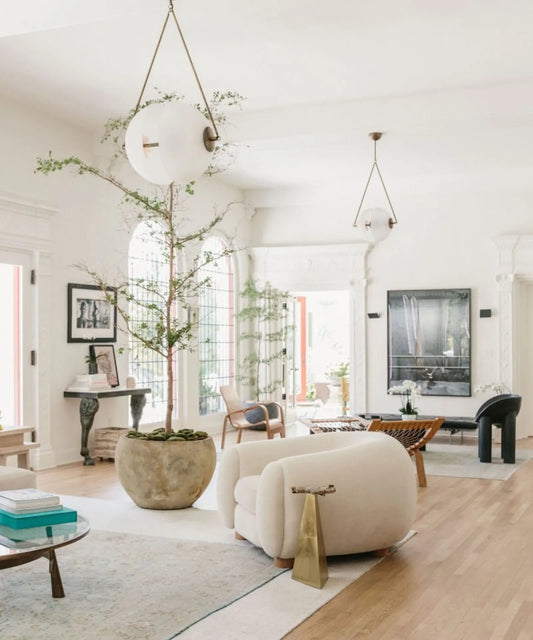Transforming your home into a Zen sanctuary with plants is a wonderful way to infuse tranquility, balance, and natural beauty into your space. Zen design focuses on simplicity, mindfulness, and creating a harmonious connection between the environment and the individual. Plants are the perfect way to accomplish this because they not only enhance the aesthetic but also improve air quality and promote relaxation. Here's a guide on how to make your home Zen with plants:
1. Embrace Minimalism in Your Plant Selection
- Less is More: Zen spaces thrive on simplicity and the removal of clutter. Instead of over-crowding your home with plants, focus on a few well-chosen ones that evoke calm and contribute to the overall balance of the space.
- Choose Simple Forms: Select plants with clean lines and minimalist shapes. Avoid plants with busy or overly decorative foliage. Plants like snake plants, bamboo, or peace lilies are perfect because of their simple and elegant forms.
2. Use Plants with Symbolic Meaning
- Bamboo: Symbolizes strength, resilience, and good luck. It's often used in Zen spaces to bring positive energy and growth.
- Ficus (Ficus lyrata): The fiddle leaf fig or rubber tree is a popular choice for adding balance and calm with its large, structured leaves.
- Bonsai Trees: These miniature trees represent patience and balance, making them a perfect focal point for a Zen space.
- Aloe Vera: Symbolizes healing and rejuvenation, aligning with the Zen principle of wellness and care.
- Succulents: Known for their resilience, succulents represent endurance and simplicity, key elements in Zen philosophy.
3. Create Symmetry and Balance
- Group Plants in Odd Numbers: In Zen philosophy, asymmetry is often seen as a form of balance. Grouping plants in odd numbers (3, 5, or 7) feels more natural and pleasing to the eye.
- Use Plant Stands for Height Variation: To maintain balance in your space, use plant stands, hanging planters, or shelves to add height variation to your plant arrangements. Taller plants like bamboo or fiddle leaf figs can anchor the space, while smaller plants like succulents or herbs can fill in the gaps.
4. Incorporate Natural Materials in Your Planters
- Clay, Terracotta, and Stone Pots: These materials are simple and earthy, aligning with Zen's connection to nature. They give a grounded, organic feel to your space.
- Wooden Planters: Wooden or bamboo planters add a natural, warm touch to the room. Choose simple, unadorned wooden planters to maintain the minimalist aesthetic.
- Glass and Concrete Pots: If you prefer a more modern, industrial Zen style, concrete or clear glass pots can bring a clean, minimalist edge to the design.
5. Place Plants Strategically for Harmony
- Corners and Empty Spaces: Place taller plants like bamboo or fiddle leaf figs in corners to add height and fill empty spaces without overwhelming the room.
- Low-Level Plants: Smaller plants like succulents or air plants can be placed on coffee tables, bookshelves, or window sills. These plants should be easy to reach and allow for interaction, encouraging a sense of connection to nature.
- Create a Meditation Nook: Dedicate a small corner for meditation or quiet time, surrounding it with plants like bonsai, peace lilies, or calatheas. The plants will create a serene atmosphere and reinforce the sense of peace.
- Windowsills: Many plants thrive in natural light, so use windowsills to display plants that need sunlight, like succulents, cactus, or herbs. The light will enhance the calming energy of the space.
6. Utilize Water Elements
- Indoor Fountains: The sound of trickling water can have a calming, meditative effect. A small indoor fountain, combined with plants like bamboo or moss, can create a soothing sensory experience in your Zen home.
- Aquatic Plants: Consider integrating water lilies, lotus flowers, or floating ferns in small containers or water features to add a peaceful, serene element to your decor.
7. Consider Lighting for a Calm Ambiance
- Natural Light: Zen spaces prioritize natural light, which nourishes both plants and people. Arrange plants near windows to allow them to bask in sunlight. Plants like snake plants or peace lilies can thrive in indirect light, while others like succulents enjoy bright, direct light.
- Soft, Ambient Lighting: Avoid harsh, bright lights. Instead, use soft, ambient lighting such as table lamps, floor lamps, or candles to create a peaceful, calming atmosphere in the room. Himalayan salt lamps can also add a warm glow and promote a tranquil environment.
8. Focus on the Five Elements of Zen
In Zen design, the five elements—Wood, Fire, Earth, Metal, and Water—are used to create balance and harmony. Here’s how plants can fit into each element:
- Wood: Use plants with tall, structural forms, like bamboo or fig trees, to bring the element of wood into the space.
- Fire: Introduce the fire element with candles or incense placed near your plants. Avoid using bright, harsh lighting, as Zen design focuses on soft, natural light.
- Earth: Earthy, grounded plants like succulents, ferns, or moss can enhance the earth element. Terracotta or stone pots also add to this connection.
- Metal: Use metal planters or decorative elements like planters in brushed copper or matte black to subtly introduce metal into your space.
- Water: Incorporate the water element with indoor fountains, aquatic plants, or simply the act of watering your plants. Water is calming and connects the space with nature.
9. Create a Zen Garden (Indoor or Outdoor)
- Mini Zen Garden: Create a small Zen garden using sand, pebbles, and a few small plants like moss, succulents, or bonsai. These gardens are designed to promote relaxation and mindfulness, ideal for a quiet corner in your home.
- Terrariums: Miniature glass terrariums with plants like air plants or succulents can also serve as tranquil focal points in your home, encouraging a sense of peace and connection to nature.
10. Mindful Plant Care
- Caring for plants can become a meditative practice. Instead of rushing through watering and maintenance, take time to nurture each plant with attention and patience. Consider it a ritual of mindfulness—something that fosters a deeper connection to the present moment and the natural world.
Zen design is about creating a peaceful, uncluttered space that fosters mindfulness and balance. By choosing the right plants—simple, balanced, and full of natural beauty—and placing them thoughtfully around your home, you can create a sanctuary that promotes calm, relaxation, and harmony. Let the plants become an integral part of your environment, inviting nature into your home and creating a space of tranquility. 🌿✨



